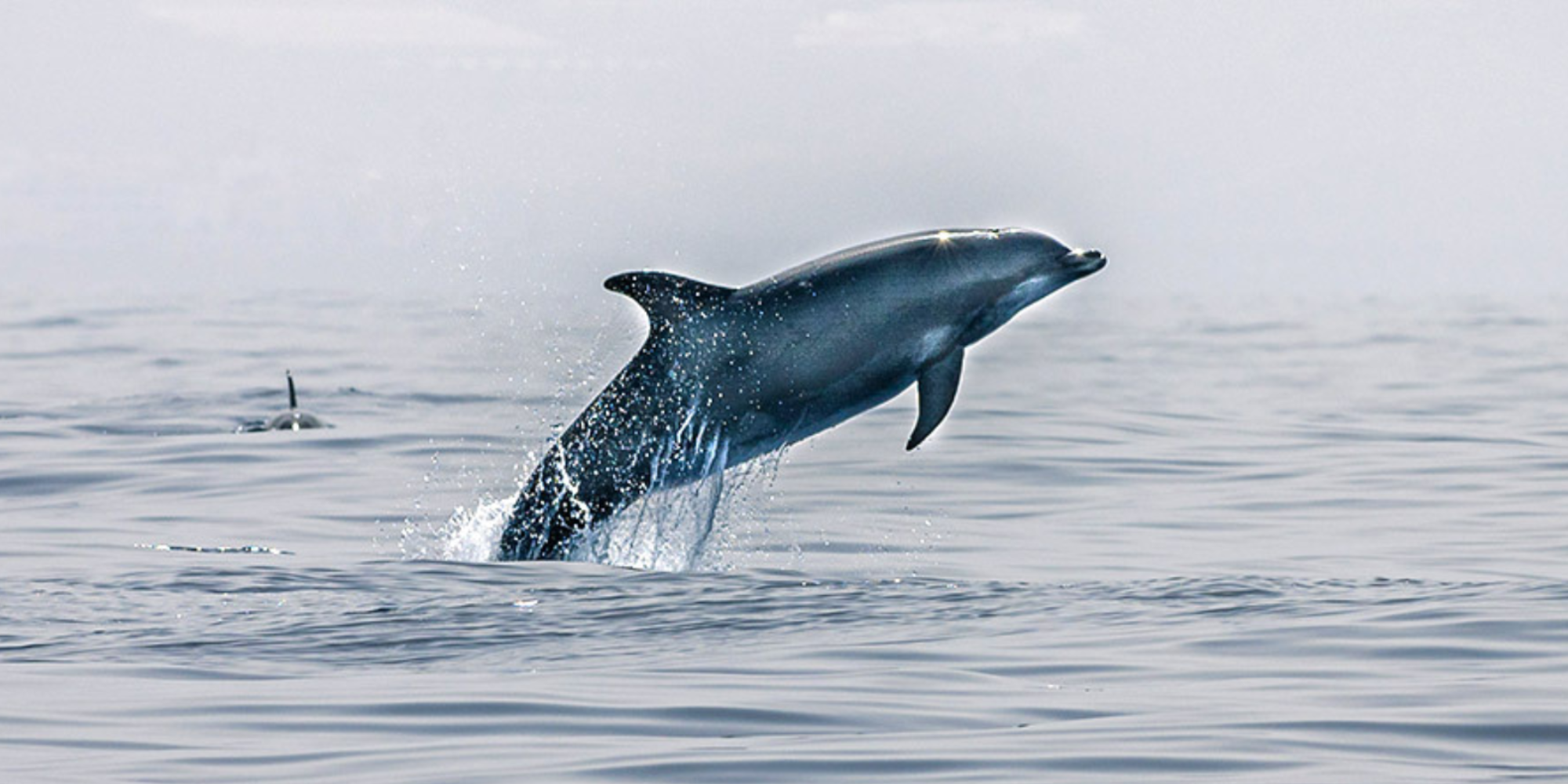The bottlenose dolphin is one of the most well-studied marine mammals in the wild. Found in both inshore and offshore waters, it weighs approximately 200 kilograms and measures up to four metres long.
There are two species of bottlenose dolphins – the common bottlenose (Tursiops truncatus) and the Indo-Pacific bottlenose (Tursiops aduncus).
The common bottlenose species is instantly recognisable by its uniform grey colour (with a paler underside), its dorsal fin, and its stubby snout and elongated jaw (which often resembles a smile).
The bottlenose is also a larger species compared to other dolphins, although the Indo-Pacific type is slightly smaller than its common bottlenose cousin. The Indo-Pacific also has spots on its belly and has more teeth.
The cetacean is often known for its active and acrobatic style. It often breaches the water and bow rides with boats, regularly reaching speeds of up to 20 kilometres an hour.
Highly intelligent, the bottlenose dolphin travels alone or in groups (often the groups break apart and later reform). Bottlenoses have complex social structures and are generally quite curious, often approaching people to investigate what’s going on. When resting in groups, the species forms tight groups.
Bottlenose dolphins living closer to the coasts tend to be more territorial (squirmishes with harbour porpoises have been known to happen), while oceanic populations are more migratory in nature.
The dolphins use sound and echolocation, both to communicate and to hunt for food. Many of us would be aware of the interesting system of squeaks and whistles that they use.
Recent research by the University of Rostock in Germany has revealed a fascinating new discovery about bottlenose dolphins. Already well-known for their intelligence and activeness, they’re now suspected to have an additional sensory ability – being able to detect weak electric fields. Find out more about in this Earth.com article.
They have relatively long lifespans, with an average life expectancy of 40 years. Females have been observed outliving their male counterparts, reaching 60 years of age or more. Some individuals are known to be reproductively active for their whole lives, which is unusual among mammals.
The common bottlenose dolphin is listed as ‘least concern’ status on the IUCN Red List while the Indo-Pacific species is listed as ‘near threatened’ status.
Where do bottlenose dolphins live?
The common bottlenose dolphin is found in both inshore and offshore waters, typically found in temperate and tropical regions throughout the Atlantic, Pacific and Indian oceans.
The Indo-Pacific bottlenose prefers warmer waters and is usually spotted in the Indian Ocean and western Pacific Ocean. They prefer shallow coastal waters and can often be seen in or around estuaries (one particular group, for instance, has made their home in the busy Port River in Adelaide, Australia).

What do they eat?
Bottlenose dolphins are quite adaptable, adjusting their food source depending on their environment. Most often, they will eat salmon, blue whiting, pollock, squid and crustaceans (shrimp and crabs).
They often work together to herd fish into groups, and then take turns swimming through the school of fish to feed themselves. They also use high frequency echolocation to locate their prey.
When they’re eating, they grip the fish with their teeth and then swallow it whole so the spines of the fish don’t catch in their throats. Bottlenose dolphins eat up to seven kilograms of food a day.
Threats to bottlenose dolphins
Entanglement in fishing gear
Getting caught up in fishing gear is a major threat to bottlenose dolphins around the world. It can cause injury, fatigue, comprised feeding and sometimes even death.
Dolphins particularly get caught up in commercial fishing nets for tuna.
Vessel strikes
Bottlenose dolphins are at risk of vessel strikes throughout their range but the threat is much higher in areas with busy ship traffic.
Environmental change and pollution
Climate change and pollution are a threat to all dolphins and whales because of the loss of habitat as waters become warmer.
Plastics and microplastics, along with chemical pollutants, entering into the water system are a serious threat to all creatures in our ocean.
Research shows that bottlenose dolphins in areas affected by the 2010 Deepwater Horizon oil spill were found to have compromised immune systems and decreased reproductive ability. Bottlenose dolphins living near the shore are more susceptible to habitat destruction and pollution caused by contaminants and oil spills.
Bottlenose dolphins can also be affected by harmful algal blooms, when they absorb toxins through the air or by eating contaminated prey. It can cause health issues or even death.
Bottlenose dolphins, like other cetaceans, use noise to communicate and to locate prey. Increased noise pollution from vessels and other human activity interferes with this ability.
Hunting/Predators
Bottlenose dolphins were once widely hunted for meat and oil, but that has fallen away over the years. Sadly, though, some limited dolphin hunting still occurs around the world.
As with other dolphin species, bottlenose dolphins are occasionally the prey of orcas and large sharks.
